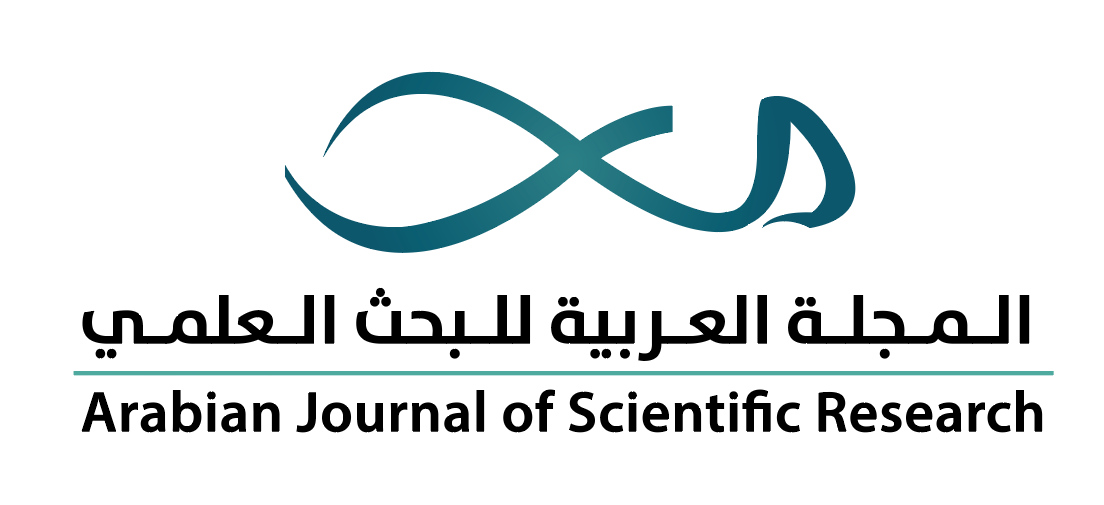-
oa تأثير حامض آندول البيوتريك (IBA) والصنف في تجذير العقل المتخشبة لشجيرات العنب اليمني (Vitis vinifera L) تحت جو المشتل
- Source: Arabian Journal of Scientific Research-المجلة العربية للبحث العلمي, Volume 5 (2024), Issue 1, Apr 2024, 4
-
- 12 October 2023
- 22 March 2024
- 30 April 2024
Abstract
الملخص
العنب اليمني من ألذ أنواع العنب، ويُستهلك بشكل عنب مائدة أو يُجَفَّف إلى زبيب ذي مذاق متميز وجودة عالية، رغم الأهمية الاقتصادية العالية لهذا المحصول إلا أن هناك قلةً في البحوث المتعلقة بإكثاره خضريّاً، وأُجري البحث بهدف دراسة تأثير حامض آندول البيوتريك (IBA) والصنف على تجذير العُقل الخشبية للعنب اليمني في مشاتل أورقانك يمن في العاصمة اليمنية صنعاء. وجُمعت العقل المتخشبة للأصناف الثلاثة قيد الدراسة (العاصمي (B1)، الرازقي (B2)، الأسود (B3) في نهاية الشتاء ونهاية طور الراحة للأشجار ونُقلت للمشتل، وتُرك النصف منها كشاهد (A1) وعومل النصف الآخر بواسطة IBA بتركيز 1000 مليغرام/لتر(A2)، وزُرعت كل العقل في بيئة تجذير موحدة، وصُمم البحث في تجربة عاملية بعاملين وفقاً للتصميم الكامل العشوائية (CRD)، كما دُرست مجموعة من صفات النمو الجذري والخضري علاوةً على النسبة المئوية للتجذير بعد مرور 58 يوماً من الزراعة. وأظهرت النتائج تسجيل عامل الصنف فروقاً معنوية للصفات المدروسة: النسبة المئوية للعقل التي كونت كالساً%، والنسبة المئوية للتجذير%، وعدد الجذور/عقلة، وطول الجذر (سم)، وقطر الجذر (مم)، في حين سجلت المعاملة A2 قيمة أعلى (33.88%) بفرق معنوي على الشاهد A1 (9.52%) في النسبة المئوية للعقل التي كونت كالساً، وكذلك في صفة قطر الجذر (1.77مم، 1.42مم) على الترتيب، بينما كان اختلاف القيم لبقية الصفات المدروسة غير معنوي. والتداخل من جهته أظهر أن الصنف العاصمي في معاملة (A1) ومعاملة (A2) سجل بشكل معنوي أعلى القيم (100%، 76.84%) على الترتيب مقارنةً بالصنفين الآخرين في كلا المعاملتين، وذلك لصفة النسبة المئوية للتجذير، بالمقابل سجل الصنف الأسود في كلا المعاملتين A1 وA2 أعلى القيم (46.66%، 28.57%) على الترتيب مقارنة بالصنفين الآخرين، وذلك لصفة النسبة المئوية للعقل التي كونت كالساً، أيضًا تفوق الصنف العاصمي في عدد، وطول، وقطر الجذر في المعاملتين A1 وA2 مقارنةً بالصنفين الآخرين لنفس المعاملتين والصفات. وعلى النقيض من ذلك، لم تُسَجَّل فروقٌ معنوية بين A1 وA2 والأصناف الثلاثة في النسبة المئوية للنمو الخضري، وعدد الأوراق/عقلة، وارتفاع العقلة. وأثبت البحث كفاءة إكثار العنب بطريقة العقلة الساقية المتخشبة بوجود الهرمون النباتي أو غيابه، ولعب الصنف دوراً معنويّاً أكثر مقارنة بوجود أو غياب الهرمون.
Yemeni grapes are among the most delectable grape varieties. They are consumed as table grapes or as raisins of superior flavor and quality. Despite the economic significance of this grape, little research has been conducted on its vegetative propagation. The purpose of the study was to assess the effect of indole butyric acid (IBA) and the cultivar on the rooting of hardwood cuttings of Yemeni grapes in Sana'a's Organic Yemen nurseries. The hardwood cuttings of the three studied grape cultivars (Al-Asmi (B1), Al-Razqi (B2), and Al-Aswad (B3) were collected at the end of winter and the end of the trees' dormant phase and then transferred to the nursery for further treatments. Half were left untreated (A1), while the other half were treated with IBA at a concentration of 1000 mg/L (A2), and all cuttings were planted in the same rooting medium. The research consisted of two factors and was designed as a factorial experiment in accordance with a completely randomized design (CRD). In addition to the percentage of rooting after 58 days of planting, the set of root and vegetative growth characteristics was investigated. The results revealed that the cultivar factor recorded significant differences for the studied traits, i.e. the percentage of cuttings with callus%, the percentage of rooting%, the number of roots/cuttings, the root length (cm), and the root diameter (mm), whereas the treatment with the hormone (A2) recorded a higher value (33.88%) with a significant difference over the control (A1) (9.52%) in the characteristic of the percentage of cuttings that formed a callus, as well as in contrast, the Al-Aswad CV recorded in both treatments A1 and A2 the highest values (46.66% and 28.57%) compared to the other two cultivars with respect to the percentage of rooting. In contrast, no significant differences were observed between A1 and A2 and the three cultivars in terms of vegetative growth percentage, number of leaves per cutting, or cutting height (cm). The research demonstrated the efficacy of grape propagation by stem cuttings in the presence or absence of the plant hormone, with the cultivar playing a more significant role than the presence or absence of the hormone.


